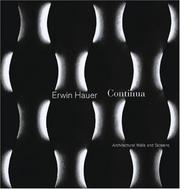| Listing 1 - 10 of 11 | << page >> |
Sort by
|
Book
Year: 1969 Publisher: München Verlag Georg D.W. Callwey
Abstract | Keywords | Export | Availability | Bookmark
 Loading...
Loading...Choose an application
- Reference Manager
- EndNote
- RefWorks (Direct export to RefWorks)
Architecture --- demountable partitions --- partitions [interior walls]
Book
Year: 1956 Publisher: Gaithersburg, MD : U.S. Dept. of Commerce, National Institute of Standards and Technology,
Abstract | Keywords | Export | Availability | Bookmark
 Loading...
Loading...Choose an application
- Reference Manager
- EndNote
- RefWorks (Direct export to RefWorks)
Flame spread. --- Interior walls --- Fire testing.
Book
ISBN: 1610601971 Year: 2011 Publisher: Minneapolis : Quarto Publishing Group USA,
Abstract | Keywords | Export | Availability | Bookmark
 Loading...
Loading...Choose an application
- Reference Manager
- EndNote
- RefWorks (Direct export to RefWorks)
"Includes all the essential information for painting interior rooms with popular techniques"--Provided by publisher.

ISBN: 1568984553 Year: 2004 Publisher: New York (N.Y.) : Princeton architectural press,
Abstract | Keywords | Export | Availability | Bookmark
 Loading...
Loading...Choose an application
- Reference Manager
- EndNote
- RefWorks (Direct export to RefWorks)
Design --- Interior walls. --- Light in architecture. --- Modular coordination (Architecture). --- History
Book
ISBN: 9023812980 Year: 1981 Publisher: Leiden Spruyt, Van Mantgem & De Does BV
Abstract | Keywords | Export | Availability | Bookmark
 Loading...
Loading...Choose an application
- Reference Manager
- EndNote
- RefWorks (Direct export to RefWorks)
Building design --- Civil engineering. Building industry --- king-post roofs --- partitions [interior walls] --- systeembouw machines
Book
Year: 1989 Publisher: Washington, D.C. : Technical Preservation Services, National Park Service, U.S. Dept. of the Interior,
Abstract | Keywords | Export | Availability | Bookmark
 Loading...
Loading...Choose an application
- Reference Manager
- EndNote
- RefWorks (Direct export to RefWorks)
Plastering --- Historic buildings --- Interior walls --- Ceilings --- Conservation and restoration --- Conservation and restoration.

ISBN: 9781568987279 1568987277 Year: 2004 Publisher: New York : Princeton Architectural Press,
Abstract | Keywords | Export | Availability | Bookmark
 Loading...
Loading...Choose an application
- Reference Manager
- EndNote
- RefWorks (Direct export to RefWorks)
Design --- Interior walls --- Screens --- Modular coordination (Architecture) --- Light in architecture. --- Murs intérieurs --- Ecrans (Mobilier) --- Coordination modulaire (Architecture) --- Lumière en architecture --- History --- Histoire --- Hauer, Erwin,
Book
ISBN: 9783900305543 3900305544 Year: 2009 Volume: 11 Publisher: Wien Österreichisches Archäologisches Institut
Abstract | Keywords | Export | Availability | Bookmark
 Loading...
Loading...Choose an application
- Reference Manager
- EndNote
- RefWorks (Direct export to RefWorks)
A Diateichisma is part of a city ́s fortification system. Unlike a city wall it was built within the urban area dividing a city in two parts. This study focuses on two aspects. On the one hand, the phenomenon of diateichismata is considered as part of fortification architecture, on the other hand the influence of diateichism on the organisation of the urban space is pointed out. Furthermore, the reasons, why diateichismata were build are considered as a focal point of the study. The settlement are displayed in a catalogue, technical data is in charts. Written sources mentioning diatechisma are put together including relevant passages of the text. In scientific research diateichismata have been regarded as mere functional buildings, however, they have been studied systematically. In this study, the significance of diateichismata is analysed beyond the aspects of fortification; in particular, the impact of diateichismata on the development and utilisation of urban space is a spezial interest. A comparative analysis of settlements with diateichisma has needs of comparable criteria. The most applicable term, after which settlements with diateichisma can be discerned and put in order, is the chronological relation of diateichisma and city wall, because here chronology is the only variable giving valuable information on settlement development. Hence three variations of settlements with diateichisma can be discerned: 1. Settlements with diateichisma built together with the enceinte. 2. Settlements with secondarily but diateichisma. 3. Settlements with diateichisma which originate after expansion of walled urban space. Most of the studied settlements have diateichismata which were built after the enceinte (23 examples) or which origins from expansion of walled city space (19 settlements). Contemporaneous diateichismate are rare (14 settlements), only in a few cities the relation between diateichisma and city wall remains unclear. The earliest diateichismata be dated in late 7th cent. B.C., the latest was build in the middle of the 2nd cent. B.C. Within this chronological frame the highest concentration of diateichismata can be traced in classical and hellenistic times. The distriution of cities is spead from the Iberian Peninsula to Greek parts of modern Afghanistan (Graeco-bactria). Only any regions do show concentrations of settlements with diateichisma. In the Western Mediterranean there are more cities with secondarily built diateichisma, in the area of north-western Greek in a lot of cities the walled urban space was enlarged establishind diateichismata between the original city area and the newly acquired space. Generally, diateichismata serve as obstacles to enemies which conquered the enceinte already or as barrier wall for hostile parties fighting within the boundaries of the city wall. Despite of the clear military function only cities of military character have a diateichisma; there it always serves as a barrier wall protecting free space Meant to host soldiers when attacked. The predominate group of settlements with dateichisma are free poleis. Concerning poleis in Greek cities in a non-Greek environment, the significance of diateichismata gains more interest, envolving the conflicts of different ethnical groups. In these cities ("colonies") one can detect mostly enlargement of urban space with covers the period of the 5th to the middle 3rd centuries B.C. Probably this process is conneted with the moving of large groups of people by the Western Greek tyrants in late archaic classical times and with the renewed founding of cities in the 4th cent. B.C. Contrary of the processs of enlargement of city space, in some areas of the Western Mediterranean cities were diminished insize. Diateichismata have a deep impact on the organisation of the urban space and also have representative and determine function. In most cities diateichismata remain standing as a ruin, detached from their original function of a barrier wall, or they integrated in newly erected buildings. As barrier walls, however, they are always organisation of urban space and remain as a visible borderline between different city quaters. Most of these partitioned off areas were used as dwelling space, but also in quite a lot of settlements explicitly the trading harbour zones were separated and protected by a diateichisma. Only a few cities divided military areas. Generally, empty space seperated by diateichisma was kept free for people escaping when being attacked. A main reason or occasion to build a diateichisma is the development of sieging techniques from late classical times onwards, being accompanied by a regional declining population density. Hence, especially in late classic and hellenistic times the erection of a diateichisma is a proved method to protect a city. However, a regional visible contemporanous development of urban space, probably connected with regional economic upturns, shows that the phenomenon of cities divided by a diateichisma is not a uniform development of military architecture. Rather a diateichisma is a mirror of the economic and political situation of a settlement and in special cases also of a region.
City walls, --- Fortification, Greek. --- Cities and towns, Ancient --- Military architecture --- Architecture, Greek --- Fortification --- Excavations (Archaeology) --- Interior walls --- City planning --- Cities and towns --- Civic planning --- Land use, Urban --- Model cities --- Redevelopment, Urban --- Slum clearance --- Town planning --- Urban design --- Urban development --- Urban planning --- Land use --- Planning --- Art, Municipal --- Civic improvement --- Regional planning --- Urban policy --- Urban renewal --- Walls --- Fortification, Primitive --- Forts --- Military engineering --- Siege warfare --- Greek architecture --- Architecture --- Architecture and war --- Greek fortification --- Classical antiquities --- Village walls --- History. --- Government policy --- Management --- Greece --- Antiquities. --- City walls --- Villes fortifiées --- Fortifications grecques --- Villes antiques
Book
ISBN: 9780985656102 0985656107 Year: 2016 Publisher: Lee, Massachusetts WallpaperScholar.com
Abstract | Keywords | Export | Availability | Bookmark
 Loading...
Loading...Choose an application
- Reference Manager
- EndNote
- RefWorks (Direct export to RefWorks)
Wallpaper --- Interior walls --- Decoration and ornament, Early American. --- 747 --- 745.521 --- 676.267 --- Early American decoration and ornament --- Decoration and ornament --- Interior decoration --- Wall-paper --- Decorative paper --- Wall coverings --- Paperhanging --- 676.267 Decorative papers (treated by mechanical means). Patterned paper. Marbled paper. Embossed paper. Cre_*pe paper. Clupak --- Decorative papers (treated by mechanical means). Patterned paper. Marbled paper. Embossed paper. Cre_*pe paper. Clupak --- 745.521 Meubelstoffen. Gordijnen. Wandbekleding --- Meubelstoffen. Gordijnen. Wandbekleding --- 747 Interieurkunst. Binnenhuisarchitectuur --- Interieurkunst. Binnenhuisarchitectuur --- History. --- Decoration. --- wallpapers --- Applied arts. Arts and crafts --- applied decoration --- Decoration and ornament, Early American --- History --- Decoration
Book
Abstract | Keywords | Export | Availability | Bookmark
 Loading...
Loading...Choose an application
- Reference Manager
- EndNote
- RefWorks (Direct export to RefWorks)
cavity walls --- mechanics [physics] --- Structural parts and elements of building --- floors [surface elements] --- Building materials. Building technology --- thermal conductivity --- Heating, climatisation, ventilation and air conditioning --- façades --- construction [discipline] --- grouting [process] --- Criminology. Victimology --- architectonics --- building materials --- beams [structural elements] --- ceilings --- roofs --- Hygiene. Public health. Protection --- fire safety --- thermal bridges --- structural frames --- foundations [structural elements] --- Protection of buildings against external influences --- watertightness --- joinery [woodwork] --- interior walls --- risk assessment --- stairs --- Architecture --- Physics --- post-and-beam structures --- burglary protection --- Music --- waterproofing --- Building design --- balconies --- doors --- thermal insulation --- drainage --- lights [window components] --- Bouwnijverheid --- Construction --- Academic collection --- Afbouw --- Balkons --- Beglazing --- Binnenwanden --- Daken --- Deuren --- Funderingen --- Gevels --- Houtskeletbouw --- Isolatie (thermisch) --- Kokers --- Prestatieanalyse --- Ramen --- Schoorstenen --- Schrijnwerk --- Trappen --- Vloeren --- Voegen --- Waterdichting --- Woningbouw --- acoustical properties --- building physics --- stairs [series of steps]
| Listing 1 - 10 of 11 | << page >> |
Sort by
|

 Search
Search Feedback
Feedback About UniCat
About UniCat  Help
Help News
News